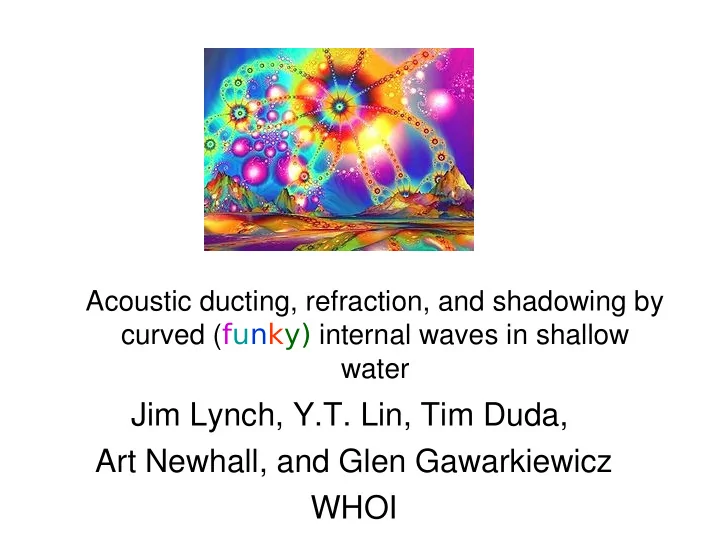

Acoustic ducting, refraction, and shadowing by curved ( funky) internal waves in shallow water Jim Lynch, Y.T. Lin, Tim Duda, Art Newhall, and Glen Gawarkiewicz WHOI
SW06 3-D View
Why put all this stuff in the water?? Sea level is rising nicely without it. What are the big issues?? • TL and its fluctuations (Katznelson, Duda, Lynch, Badiey et al) • Fully 3-D acoustics - not just slices of 3-D ocean – and direction of arrivals (Lin and Duda work) • Array coherence (Duda et al) • Inversion for bottom in presence of fluctuating ocean (Lin work) • Others…
Box 2 Solibore Simulation 0 10 20 30 Depth (m) 40 50 60 70 80 90 100 0 2 4 6 8 10 12 14 16 18 20 Range (km)
Started with SWARM Cross Shelf And a mouse…
IW Induced Coupled Propagation Gain/Loss Cases Lossy High Modes src Low Modes IW scatter PRIMER Noise Case – Net Amplification Low Modes Lossy High Modes IW scatter src Zhou Yellow Sea Case – Net Attenuation
Evolution - Boris’ Master Plan!
Oops – Boris Katznelsons IW Master Plan!
Mean intensity increase due to ducting (no spreading vs. cylindrical spreading) For IW duct, have geometry source duct w θ r Cylindrical wavefront R = Ratio of areas = r θ c /w IW duct ( r 1 =20 km, w = 1 km, θ c = 7.5 o ) 10 log R = 7.18 dB 7-8 dB is a lot for sonar systems!! (And is observed))
IW Trek – The Next Generation New IW Features to Include…. funkier! Curved IW’s Terminating IW’s Field of IW’s with horizontal decorrelation Crossing Wave Trains Capt Nick Witzell
So much for infinite plane waves…
Satellite Image Analysis
It’s this curvy!
And OMG it’s heading for New Jersey!
Put this curvature into a numerical model, see neat stuff. For instance, higher modes trap better—hmmm! Case 2 : curvature=135km, frequency = • 200Hz Modes 1 and 2 penetrate through internal • wave duct, but modes 3 and 4 focus in the duct.
Some Simple Theory • Previous work clearly displays frequency and mode dispersion effects, light piping (and leakage from curved pipe), etc. • But doesn’t have simple physical insight into how parameters of problem (frequency, mode number, IW strength, background waveguide structure, etc.) affect trapping and leakage of modes. • Looking to a simple theory picture is useful?! • Lynch an excellent choice for very simple stuff
Start with Weinberg/Burridge 3-D horizontal ray/verticalmode theory • Have a local horizontal index of refraction for each mode at a given frequency ω = n ( x , y , ) k ( r ) k ( 0 ). n n n •After get the index of refraction field by computing the modes at all x,y, then trace rays in the horizontal •Product of the ray (horizontal) and mode (vertical) gives acoustic field !!!
Trivializing IW’s 101
Simple modal waveguide model • Simple model – rigid γ = m + π H ( 1 / 2 ) n bottom background = − γ waveguide plus ML, 2 2 1 / 2 k ( k ) n n IW perturbations 2 = γ • The background Z ( z ) sin( z ) n n H eigenvalue plus the ∆ 2 qZ ( z ) dz 1 ∫ D appropriate ∆ = n k ρ n 2 k ( z ) 0 n perturbation is what ω 2 we want -> ∆ = − ∆ q 2 c ( z ) 3 c ( z ) eigenvalue at each 0 point in (x,y) ω ∆ D , H 2 IW 2 c ∫ ∆ = γ 2 k sin ( z ) dz n n 2 k H c c n 0 0 0
Frequency dependence of normal mode critical grazing angle • Perturbative formulation for critical angle 5.4 Freq = 100 Hz 5.3 Freq = 200 Hz Critical grazing angle (Deg) Freq = 400 Hz 5.2 5.1 5 Water Depth (H) = 80m 4.9 Mixed Layer Depth (D) = 15m 4.8 NLIW Depth (H IW ) = 25m c0 = 1500 m/s 4.7 ∆ c = 40 m/s 4.6 0 5 10 15 Mode number
What does Mr. Data say??
Source can be exterior to wave train, inside waves, or interior to wave train – lets look at!
Already saw interior case
Exterior gives Shadowin g • IW has critical angle of ~5 degrees (max) • Can give a shadow behind a linear IW, but only if source is within 1-2 km of IW front • Curved IW’s allow one to see shadowing for source considerably further away • Might be an observable effect in data..???
Exampleof how “falling away horizon”gives critical angle before the tangent point, and thus a shadow region behind the IW
Exterior shows the shadow… and more
Interior case - most sound penetrates
Interior – when near IW, get… whispering gallery, horizontal Lloyd’s mirror, and neat shadow zone!
Quo Vadis ? What does one see with all of • this stuff present? (for sure it’s Funky ! ) Are there distinct • signals/signatures from each “process” we’ve examined, [time, angle, frequency, intensity,..]or do they produce similar, “additive” effects? How to describe this mess - • with random medium approach…?!? What does this mean for naval • and other ocean acoustics applications?
Questions??
Recommend
More recommend